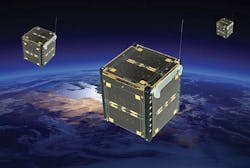Traditional radiation-hardened electronics industry facing challenges of adapting to Space 2.0
The latest round of disruptive technology in the rad-hard electronics industry involves the emerging market for small satellites (SmallSats) with limited life cycles. The aerospace industry variously calls this market New Space, or Space 2.0.
This new market direction was on clear display last week at the IEEE Nuclear and Space Radiation Effects Conference (NSREC) in Portland, Ore., as rad-hard electronics component suppliers are doing their best to gear-up for the anticipated new era.
Getting ready for Space 2.0, however, may be easier said than done -- particularly for the traditional longtime suppliers of radiation-hardened electronics parts. The transition involves not just technology, but also a whole new way of doing business.
Related: Space: the next frontier of rad-hard
"You can't just adapt the technology; you have to adapt the flexible business model," says Chris Clardy, general manager of semiconductor solutions at rad-hard specialist Cobham Advanced Electronic Solutions in Plainview, N.Y.
Making the pivot to Space 2.0 involves offering rad-hard product lines that are more affordable than ever before, and that have a wide range of radiation hardness. This is one way that the next generation of SmallSats and so-called CubeSats that will define Space 2.0 can meet system requirements while keeping costs to a minimum.
In other words, the gold-plating is all gone. Spacecraft designers involved in Space 2.0 no longer want reliability at any cost; they want reliability that's just good enough. They're looking to shave costs at the rad-hard component level, which is something they've rarely -- if ever -- done before.
Traditional rad-hard suppliers like Cobham, BAE Systems, IBM, Northrop Grumman, and others grew up in another era when reliability was everything, and cost was not nearly the concern it is becoming today. The legacy of traditional rad-hard suppliers, in fact, extends back 25 years and more to the Cold War when fears of nuclear weapons explosions in space drove requirements to enable electronics to operate through nuclear events with little, if any, disruption.
Related: Rad-hard moves into the submicron age
From a business standpoint, those electronic parts designed to operate through nuclear explosions didn't come cheap; they were some of the most expensive, rugged, and reliable components available anywhere, and satellite designers of that era were more than willing to pay their prices. Legacy satellite communications (SATCOM) systems like the Military Strategic and Tactical Relay (MILSTAR) satellites were examples of this.
With a history of reliability virtually at any cost, some of the traditional rad-hard electronic suppliers might find it difficult to make the switch to Space 2.0. That's difficult, but probably not impossible.
"There will be a traditional space market that will remain, driven by the military, with 20-year life cycles," says Anthony Jordan, vice president for product marketing and applications engineering at the Cobham semiconductor segment in Colorado Springs, Colo.
Related: BAE Systems wins certification for radiation-hardened integrated circuits for use in space
He points out that there isn't a lot of duplication now in the rad-hard electronics business, and says he doesn't expect a major industry shakeout.
Still, there's much change in the wind for the rad-hard parts industry -- not only because of the technology disruptions brought about by the end of the Cold War, and later with Space 2.0. New generations of technology employees also are expected to drive change.
"We have to look at the new Millennial talent and let them do their thing, rather than impose what we've done for the past 20 years, Cobham's Clardy says.
Learn more: search the Aerospace & Defense Buyer's Guide for companies, new products, press releases, and videos

